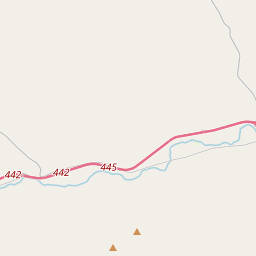First United Methodist Church of Junction
Historical marker location:






Early Junction residents built brush arbors for religious meetings, and by the 1870s, the city had an active Methodist Society, which hosted traveling ministers, such as the fiery "Fighting Parson" Andrew Jackson Potter. The Junction Methodists became a mission church of the Methodist Episcopal Church, South in 1881. Members built a sanctuary and parsonage in 1889, and the congregation continued to grow. Gov. Coke R. Stevenson, who grew up in the congregation, served on the building committee for the church's 1930 Spanish mission-style sanctuary. Today, the church continues to be a center for worship, education and community activity. (2006)
As one of the most visible programs of the Texas Historical Commission (THC), historical markers commemorate diverse topics in Texas history, including: the history and architecture of houses, commercial and public buildings, religious congregations, and military sites; events that changed the course of local and state history; and individuals who have made lasting contributions to the state, community organizations, and businesses.
The Johnson Space Center, located in Houston, played a crucial role in the development of the U.S. space program. It was here that NASA trained its astronauts and mission control teams, and it continues to be an important center for space research and exploration today.
The county was officially organized in 1876 and named after George C. Kimble, a famous Texan who fought in the Texas Revolution. During the late 19th and early 20th centuries, Kimble County experienced a period of growth and development. Railroads were built, connecting the county to other parts of Texas, which facilitated the transportation of goods and people.
The discovery of silver and lead in the county drew even more people to the area, resulting in the establishment of several mining communities. For a time, the county was a hub of mining activity, greatly contributing to its economic prosperity. However, as the mining industry declined in the early 20th century, the county shifted its focus to agriculture and ranching.
Today, Kimble County continues to embrace its rural character and agricultural heritage. It is known for its picturesque landscapes, including the beautiful South Llano River State Park. The county's economy is primarily driven by agriculture, including livestock, hunting, and pecan farming. With its combination of natural beauty, historical significance, and thriving rural lifestyle, Kimble County remains a charming part of Texas.
Kimble County Timeline
This timeline provides a concise overview of the key events in the history of Kimble County, Texas.
- 1850: Kimble County is created from parts of Bexar, Gillespie, and Mason counties.
- 1869: The town of Kimbleville is established as the county seat.
- 1873: The name of Kimbleville is changed to Junction City.
- 1882: The town is officially incorporated as Junction City.
- 1894: The name of Junction City is changed to Junction.
- 1901: The Kansas City, Mexico and Orient Railway reaches Junction, leading to an increase in population and economic growth.
- 1927: A devastating flood hits Junction, causing significant damage to the town.
- 1949: The county seat is moved from Junction to its current location in Junction City.
- 2001: The Kimble County Historical Museum opens in Junction to preserve the county's history.